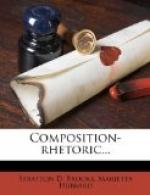SINGULAR PLURAL SINGULAR PLURAL
NOM. AND OBJ. one ones other others
POSS. one’s ones’ other’s others’
+43. Adjective Pronouns or Pronominal Adjectives.+—Many words, as has been noted already, are either pronouns or adjectives according to the office that they perform. If the noun is expressed, the word in question is called a pronominal adjective; but if the noun is omitted so that the word in question takes its place, it is called an adjective pronoun. [That house is white (adjective). That is the same house (pronoun).]
ADJECTIVES
+44. Classes of Adjectives.+—There are two general classes of adjectives: the descriptive [blue, high, etc.], so called because they describe, and the limiting or definitive adjectives [yonder, three, that, etc.], so called because they limit or define. It is, of course, true that any adjective which describes a noun limits its meaning; but the adjective is named from its descriptive power, not from its limiting power. A very large per cent of all adjectives belong to the first class,—descriptive adjectives. Proper adjectives and participial adjectives form a small part of this large class: [European countries. A running brook].
+45. Limiting or Definitive Adjectives.+—The limiting adjectives include the various classes of pronominal adjectives (all of which have been mentioned under pronouns), the articles (a, an, and the), and adjectives denoting place and number.
+46. Comparison of Adjectives.+—With the exception of the words this and that, adjectives are not inflected for number, and none are inflected for case. Many of them, however, change their form to express a difference in degree. This change of form is called comparison. There are three degrees of comparison: the positive, the comparative, and the superlative. Adjectives are regularly compared by adding the syllables er and est to the positive to form the comparative and superlative degrees. In some cases, especially in the case of adjectives of more than one syllable, the adverbs more and most are placed before the positive degree in order to form the other two degrees [long, longer, longest; beautiful, more beautiful, most beautiful].
+47. Irregular Comparison of Adjectives.+—A few adjectives are compared irregularly. These adjectives are in common use and we should be familiar with the correct forms.
POSITIVE COMPARATIVE SUPERLATIVE
bad } evil } worse worst ill }
far farther farthest




